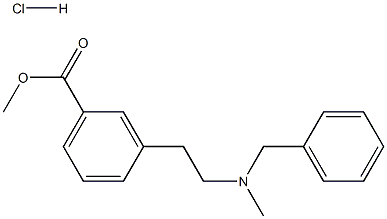PRL-8-53
- CAS NO.:51352-87-5
- Empirical Formula: C18H22ClNO2
- Molecular Weight: 319.82578
- MDL number: MFCD01660704
- EINECS: 206-141-6
- SAFETY DATA SHEET (SDS)
- Update Date: 2024-07-19 19:28:24

What is PRL-8-53?
Description
PRL-8-53 is an experimental compound which many believe to be one of the most effective memory boosters available.It is a nootropic research chemical derived from benzoic acid and phenylmethylamine with memory-enhancing effects, used in neuroscience research related to memory enhancement and protection against memory impairment.
History
The drug name of PRL-8-53 is methyl 3-2-benzyl methyl amino ethyl benzoate. It is a promising supplement that was developed in 1972 by Dr. Nikolaus Hansl at Creighton University.
Rumors and a few documents revealed that Dr. Hansl, PRL-8-147, also created a stronger version of PRL-8-53.
In 1978, Dr. Hansl conducted a human study where volunteers doubled their memory with a single dose.
This discovery made PRL-8-53 the most talked-about nootropics in the market.
Neurohackers even tagged it as a powerful supplement that boosts memory formation, retention, and recall improving the overall cognitive function.
The Uses of PRL-8-53
in medicine used in neuroscience research related to memory enhancement and protection against memory impairment.
Biological Functions
PRL-8-53 (hydrochloride) is an analytical reference standard that is categorized as a phenethylamine and a nootropic. This product is intended for research and forensic applications.
Mode of action
The exact mechanism of action of PRL-8-53 remains unknown. Doses up to 200 mg/kg are not observed to have stimulant properties, and a dosage of 20 mg/kg does not potentiate the effects of dextroamphetamine in rats. It displays possible cholinergic properties, and potentiates dopamine while partially inhibiting serotonin. PRL-8-53 reverses the catatonic and ptotic effects of reserpine.
Toxicity evaluation
PRL-8-53 is relatively non-toxic, with an oral LD50 in mice of 860 mg/kg, giving the drug a high therapeutic index. Doses above 8 mg/kg have brief hypotensive effects in canines. High doses depress motor activity in the rat and mouse, with the ED50 for a 50% reduction in motor activity of mice at 160 mg/kg. PRL-8-53 displays spasmolytic effects.
Clinical claims and research
The only human study on PRL-8-53 indicates that it may significantly boost memory, particularly in older people. ?
The double-blind study used word memorization as a measure, testing the participants’ ability to recall a list of 12 one-syllable words, first to establish a baseline and then again after ingesting PRL-8-53 or a placebo. The subjects were tested on their ability to recall the words 24 hours after hearing them and then again one week later.
The study results indicate that participants who had higher baseline scores showed the least improvement after ingesting PRL-8-53, while subjects who had demonstrated poorer initial memory or who were over 30 years of age showed significant improvement in recall.
Hansl described the effect on the older participants as follows:
“This group was age 30 or older. As might be expected, rote memory did not come as easily to this group as the younger students. The average retention after 24 hours when on placebo was just under three words out of a possible 12. The average retention after one week was two words. However, the same subjects, when learning subsequent to drug administration, retained an average of 5.85 words after 24 hours and 5.25 words after one week. Again the increases were statistically significant. The improvement expressed in percent of placebo performance was 108% for the 24-hour test and 152% for the one-week recall.”
Properties of PRL-8-53
| storage temp. | under inert gas (nitrogen or Argon) at 2-8°C |
| solubility | DMF: 30 mg/ml DMSO: 30 mg/ml Ethanol: 30 mg/ml PBS (pH 7.2): 10 mg/ml |
| form | A crystalline solid |
| InChI | InChI=1S/C18H21NO2.ClH/c1-19(14-16-7-4-3-5-8-16)12-11-15-9-6-10-17(13-15)18(20)21-2;/h3-10,13H,11-12,14H2,1-2H3;1H |
Safety information for PRL-8-53
Computed Descriptors for PRL-8-53
| InChIKey | HLBBSWSJLPLPRU-UHFFFAOYSA-N |
| SMILES | C(OC)(=O)C1=CC=CC(CCN(CC2=CC=CC=C2)C)=C1.[H]Cl |
New Products
4-AMINO-TETRAHYDRO-PYRAN-4-CARBOXYLIC ACID HCL 4-(Dimethylamino)tetrahydro-2H-pyran-4-carbonitrile 4-AMINO-TETRAHYDRO-PYRAN-4-CARBOXYLIC ACID 4-Aminotetrahydropyran-4-carbonitrile Hydrochloride (R)-3-Aminobutanenitrile Hydrochloride 5-Bromo-2-nitropyridine Nimesulide BP Aceclofenac IP/BP/EP Diclofenac Sodium IP/BP/EP/USP Mefenamic Acid IP/BP/EP/USP Ornidazole IP Diclofenac Potassium 3-Bromopyrazole (3aR,4R,5R,6aS)-hexahydro-5-Triethyl silyloxy-4-((E)-3-oxo-5-phenylpent-1- enyl)cyclopenta[b]furan-2-one. 1-Chlorocarbonyl-4-piperidinopiperidine 1-Bromo-4-phenyl-2-Butanone 4-Amino-2-fluoro-N-methylbenzamide 1,1'-Carbonyldiimidazole SODIUM AAS SOLUTION ZINC AAS SOLUTION BUFFER SOLUTION PH 10.0(BORATE) GOOCH CRUCIBLE SINTERED AQUANIL 5 BERYLLIUM AAS SOLUTIONYou may like
-
 Methyl 3-(2-(benzyl(methyl)amino)ethyl)benzoate hydrochloride 95% CAS 51352-87-5View Details
Methyl 3-(2-(benzyl(methyl)amino)ethyl)benzoate hydrochloride 95% CAS 51352-87-5View Details
51352-87-5 -
![Dimethyl [2-oxo-3-[3-(trifluoromethyl)phenoxy]propyl]phosphonate 99%](https://img.chemicalbook.in//Content/image/CP5.jpg) Dimethyl [2-oxo-3-[3-(trifluoromethyl)phenoxy]propyl]phosphonate 99%View Details
Dimethyl [2-oxo-3-[3-(trifluoromethyl)phenoxy]propyl]phosphonate 99%View Details
54094-19-8 -
 85-81-4 99%View Details
85-81-4 99%View Details
85-81-4 -
![208111-98-2 (3aR,4R,5R,6aS)-5-(Benzoyloxy)hexahydro-4-[(1E)-3-oxo-4-[3-(trifluoromethyl)phenoxy]-1-buten- 1-yl]-2H-cyclopenta[b]furan-2-one 99%](https://img.chemicalbook.in//Content/image/CP5.jpg) 208111-98-2 (3aR,4R,5R,6aS)-5-(Benzoyloxy)hexahydro-4-[(1E)-3-oxo-4-[3-(trifluoromethyl)phenoxy]-1-buten- 1-yl]-2H-cyclopenta[b]furan-2-one 99%View Details
208111-98-2 (3aR,4R,5R,6aS)-5-(Benzoyloxy)hexahydro-4-[(1E)-3-oxo-4-[3-(trifluoromethyl)phenoxy]-1-buten- 1-yl]-2H-cyclopenta[b]furan-2-one 99%View Details
208111-98-2 -
 2033-24-1 99%View Details
2033-24-1 99%View Details
2033-24-1 -
 Meldrums acid 2033-24-1 99%View Details
Meldrums acid 2033-24-1 99%View Details
2033-24-1 -
 Cyaclopentane carboxylic acid 99%View Details
Cyaclopentane carboxylic acid 99%View Details
3400-45-1 -
 2-Aminopyridine 504-29-0 99%View Details
2-Aminopyridine 504-29-0 99%View Details
504-29-0